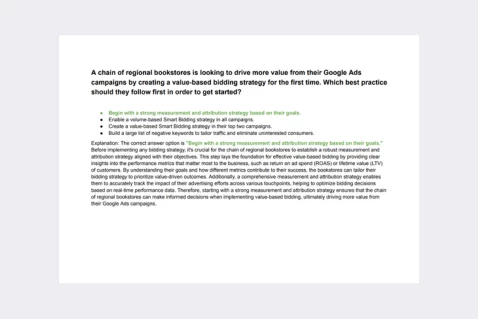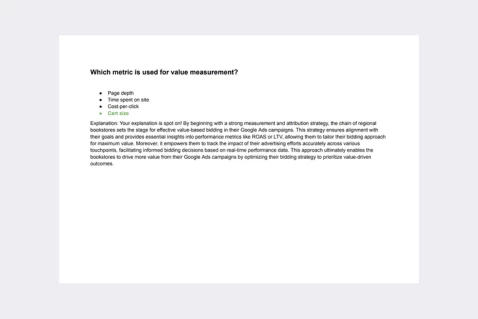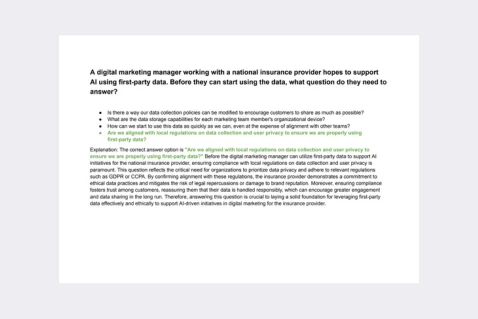Get the latest Google Ads AI-powered performance certification assessment answers. Updated to reflect exactly the latest exam experience on the new Google SkillShop platform. All possible exam questions with 100% correct answers and Explanations. Free updates.
Google Ad Ai-Powered Performance certification is the latest Google Ads category program available in Google Skillshop. Need all Google ads certifications? Check this Google Ads Roll exams bundle with answers to all Google Ads category certification exams.
Note: we perform daily scans ensuring the file corresponds exactly the latest exam version and contains all possible questions from the real certification program.



- All possible certification exam questions
- 100% correct and verified answers
- Instant download
- Detailed explanations written by experts
- Free lifetime updates.
The Google Ads AI-Powered Performance Ads Certification program offers a fantastic opportunity for marketers to delve into the cutting-edge world of AI-driven advertising. Having personally undergone the certification process, I can attest to its value in providing a comprehensive understanding of how AI can revolutionize digital advertising strategies. From optimizing bids to maximizing conversions, this certification equips you with the knowledge and skills needed to harness the full potential of AI in driving campaign performance.
Passing exams is not a workout. Multiple attempts won’t make you stronger.
Preparing for the certification exam can be a daunting task, but with the right resources, it becomes much more manageable. Our guide, containing a curated collection of exam questions, answers, and detailed explanations, serves as an invaluable tool in your preparation journey. By utilizing this guide, you not only familiarize yourself with the exam format but also gain deeper insights into the underlying principles and strategies behind AI-powered performance advertising. With our guide by your side, you can approach the exam with confidence, knowing that you’re well-equipped to tackle any challenge that comes your way.
I highly encourage aspiring marketers to take advantage of the Google Ads AI-Powered Performance Ads Certification program and leverage our guide to streamline their preparation process. Whether you’re looking to enhance your skillset, advance your career, or stay ahead of industry trends, this certification serves as a testament to your expertise in the dynamic field of digital advertising. Don’t miss out on the opportunity to elevate your credentials and unlock new possibilities in your professional journey.
Get familiar with the exam questions:
A local dessert chain is looking to improve its Google Ads campaign performance across its accounts. What are two ways it can use its optimization score to improve its campaigns? (Choose two.)
- By determining the extent to which campaigns can be improved and how to go about making improvement
- By the review and dismissal of recommendations that are relevant to their goal to save time optimizing campaigns
- By accepting and immediately applying recommendations tailored to their business, which can save time
- By measuring their score at the individual account level but not their manager account level
Explanation: The correct answer options are “By determining the extent to which campaigns can be improved and how to go about making improvement” and “By accepting and immediately applying recommendations tailored to their business, which can save time.” The optimization score in Google Ads serves as a valuable tool for assessing the performance and potential enhancements of campaigns. By understanding the extent to which campaigns can be improved, businesses can prioritize their optimization efforts effectively, allocating resources where they are most needed. This not only enhances the overall performance of campaigns but also streamlines the optimization process. Additionally, by accepting and promptly implementing recommendations tailored to their specific business needs, companies can save valuable time that would otherwise be spent manually fine-tuning their campaigns. This approach ensures that optimization efforts are targeted and efficient, leading to better campaign outcomes. Therefore, these two options capitalize on the optimization score’s insights to drive meaningful improvements in campaign performance and streamline the optimization process, aligning with the goals of the local dessert chain to enhance their Google Ads campaign performance.
A chain of regional bookstores is looking to drive more value from their Google Ads campaigns by creating a value-based bidding strategy for the first time. Which best practice should they follow first in order to get started?
- Begin with a strong measurement and attribution strategy based on their goals.
- Enable a volume-based Smart Bidding strategy in all campaigns.
- Create a value-based Smart Bidding strategy in their top two campaigns.
- Build a large list of negative keywords to tailor traffic and eliminate uninterested consumers.
Explanation: The correct answer option is “Begin with a strong measurement and attribution strategy based on their goals.” Before implementing any bidding strategy, it’s crucial for the chain of regional bookstores to establish a robust measurement and attribution strategy aligned with their objectives. This step lays the foundation for effective value-based bidding by providing clear insights into the performance metrics that matter most to the business, such as return on ad spend (ROAS) or lifetime value (LTV) of customers. By understanding their goals and how different metrics contribute to their success, the bookstores can tailor their bidding strategy to prioritize value-driven outcomes. Additionally, a comprehensive measurement and attribution strategy enables them to accurately track the impact of their advertising efforts across various touchpoints, helping to optimize bidding decisions based on real-time performance data. Therefore, starting with a strong measurement and attribution strategy ensures that the chain of regional bookstores can make informed decisions when implementing value-based bidding, ultimately driving more value from their Google Ads campaigns.
Which metric is used for value measurement?
- Page depth
- Time spent on site
- Cost-per-click
- Cart size
Explanation: Your explanation is spot on! By beginning with a strong measurement and attribution strategy, the chain of regional bookstores sets the stage for effective value-based bidding in their Google Ads campaigns. This strategy ensures alignment with their goals and provides essential insights into performance metrics like ROAS or LTV, allowing them to tailor their bidding approach for maximum value. Moreover, it empowers them to track the impact of their advertising efforts accurately across various touchpoints, facilitating informed bidding decisions based on real-time performance data. This approach ultimately enables the bookstores to drive more value from their Google Ads campaigns by optimizing their bidding strategy to prioritize value-driven outcomes.
A digital marketing manager working with a national insurance provider hopes to support AI using first-party data. Before they can start using the data, what question do they need to answer?
- Is there a way our data collection policies can be modified to encourage customers to share as much as possible?
- What are the data storage capabilities for each marketing team member’s organizational device?
- How can we start to use this data as quickly as we can, even at the expense of alignment with other teams?
- Are we aligned with local regulations on data collection and user privacy to ensure we are properly using first-party data?
Explanation: The correct answer option is “Are we aligned with local regulations on data collection and user privacy to ensure we are properly using first-party data?” Before the digital marketing manager can utilize first-party data to support AI initiatives for the national insurance provider, ensuring compliance with local regulations on data collection and user privacy is paramount. This question reflects the critical need for organizations to prioritize data privacy and adhere to relevant regulations such as GDPR or CCPA. By confirming alignment with these regulations, the insurance provider demonstrates a commitment to ethical data practices and mitigates the risk of legal repercussions or damage to brand reputation. Moreover, ensuring compliance fosters trust among customers, reassuring them that their data is handled responsibly, which can encourage greater engagement and data sharing in the long run. Therefore, answering this question is crucial to laying a solid foundation for leveraging first-party data effectively and ethically to support AI-driven initiatives in digital marketing for the insurance provider.
- A local dessert chain is looking to improve its Google Ads campaign performance across its accounts. What are two ways it can use its optimization score to improve its campaigns? (Choose two.)
- A chain of regional bookstores is looking to drive more value from their Google Ads campaigns by creating a value-based bidding strategy for the first time. Which best practice should they follow first in order to get started?
- Which metric is used for value measurement?
- A digital marketing manager working with a national insurance provider hopes to support AI using first-party data. Before they can start using the data, what question do they need to answer?
- What’s the benefit of running a true A/B test with campaign experiments?
- What’s a best practice to follow when designing an experiment to test Performance Max campaigns?
- Which Smart Bidding strategy would you utilize to optimize for value?
- In traditional marketing organizations, how is budgeting usually handled?
- A digital marketing manager has chosen to upgrade keywords to broad match. Which of these behaviors should they incorporate into their routine optimization cadence in order to guide machine learning?
- What role do negative keywords play in a AI-powered Search strategy?
- How does a test-and-learn mindset help marketers find success in their AI efforts?
- Which of the following tools can help marketers maximize performance of a value-based bidding strategy?
- What’s a best practice to follow when creating a Performance Max campaign?
- A digital marketer has upgraded their Smart Bidding strategy to value-based bidding. Which two Google Ads tools should they use regularly? (Choose two.)
- What are two ways that Performance Planner can help you plan budgets? (Choose two.)
- What’s a best practice when building an account structure designed to improve the performance of AI-powered solutions?
- Why are broad match keywords so important?
- A digital marketing manager for a large retailer manages a fully flexible budget for their campaigns. Which best practice should they follow in order to maximize results from their flexible budget?
- How does uncapping budgets help to fully capture AI’s benefits?
- What’s an important benefit of opting into automatically applied recommendations?
- Which marketing behavior can be done by AI in Google Ads? (Choose three.)
- A digital marketing manager notices the Ad Strength rating of their Responsive Search Ads could be improved. What action can they take to improve Ad Strength?
- What’s the significance of conversion delay?
- In a fully AI-powered strategy, which of these three Search features work with one another to deliver performance?
- When creating a campaign experiment, which is a best practice?
- Which of the following available insights are designed to help advertisers discover consumer interest and category growth trends?
- A local automobile dealership is creating a Performance Max campaign to drive more visits to their location. Which goal should they choose when setting up a new Performance Max campaign?
- An online shoe retailer is looking to create a Performance Max campaign to help drive sales in their sneaker category. How should they get started with Performance Max?
- An advertiser’s marketing objective is to generate leads. How can they optimize their Performance Max campaigns for value?
- When developing image assets, which of these practices can help drive success?
- How can a Performance Max campaign help an ice cream shop drive more potential customers to their physical location?
- On a fixed annual budget, what’s an effective way to ensure that you have the budget flexibility you need to experiment with campaigns to test their effectivenes?
- Which value definition is commonly used in measurement strategies that are value-centric?
- If an organization was moving to a value-based bidding strategy for their digital marketing campaigns but needed to operate within a fixed budget, which of these Smart Bidding strategies would meet their needs?
- If a marketer’s goal was to drive more value from lead generation campaigns, why would value-based bidding be a viable solution?
- If digital leaders want to support Google’s AI, which of these steps should be their priority
- Which AI-powered solution delivers the biggest channel and inventory coverage of any Google Ads campaign?
- What’s a strong example of a business objective that is required when adopting an AI-powered solution?
- How does a Performance Max campaign work to find potential customers for an advertiser?
- When keywords are created, what is their default match type?
- Which of these are two key benefits of using the Insights page? (Choose two.)
- What are the ways that Explanations can be used to improve the performance of campaigns?
- What are two ways that the Combination and Assets Report can help a marketer imrpove their creative assets’ performance? (Choose two.)
- In which two ways does the insights page help make performance evaluation workflows simpler? (Choose two.)
- Why are Responsive Search Ads valuable?
- For an online sneaker retailer trying to reach a target return metric in the upcoming year, which Smart Bidding strategy can help them meet their goals?
- Which is regarded to be a best practice for using Performance Planner?
- A marketer wants to use Google’s AI solutions to drive more value from their marketing. They know they need to fuel AI with their own privacy-safe data. Which reason describes why their data is valuable to fueling AI?
- A merchant that wants to grow its online sales is testing different campaign optimizations designed to connect them to more potential customers. What value do these experiments have for the merchant?
- A local bakery chain is starting up a Performance Max campaign in hopes of attracting more customer visits to their brick-and-mortar shops. What should they establish as a goal when creating their new Performance Max campaign?
- A digital marketing manager knows that their organization has a fixed annual budget for the upcoming year. In order to test new initiatives, they will need some flexibility to create campaign experiments. Which best practice should they follow in order to create budget flexibility within their clearly defined annual budget?
- Which of the following is considered a best practice when using Performance Planner?
- If a digital marketing manager was to upgrade their keywords to broad match, which behavior should they incorporate into their routine optimization efforts in order to guide machine learning?
- Which of these marketing behaviors can be done by AI in Google Ads? (Choose three.)
- When creating an account structure designed to improve AI-powered solutions’ performance, which is a best practice?
- Which three Search features work together to drive performance in a fully AI-powerd strategy?
- A digital marketing manager is looking to use Performance Planner to create his budget plans. What are two ways that Performance Planner can help him with budget planning? (Choose two.)
- Which is a key benefit of opting into automatically applied recommendations?
- How can campaign performance be improved through the use of Explanations?
- A local pizza chain is looking to improve their Google Ads campaign performance across their accounts. What are two ways that they can use their optimization score to improve campaigns? (Choose two.)
- What’s a common type of value definition used in value-centric measurement strategies?
- An online retailer has a goal of increasing the value they see from their Search campaigns, and the Chief Marketing Officer has set a target return metric they need to achieve in the coming year. Which Smart Bidding strategy is the right fit for this organization?
- Which of these insights are intended to help advertisers understand consumer interest and category growth trends?
- A digital marketing manager is transitioning their campaigns to a value-based bidding strategy. They want to drive more value from their campaigns, but need to operate within a fixed budget. Which Smart Bidding strategy is the right fit for this organization?
- When working with a value-based bidding strategy, which of these tools can help drive maximum performance?
- Which of the following is considered a best practice when creating effective image assets?
- When designing an experiment to test Performance Max campaigns, which is a best practice to follow?
- In traditional marketing organizations, which of these is a typical budgeting strategy?
- A digital marketer has incorporated value-based bidding into their Smart Bidding strategy. Which two Google Ads tools should they consider? (Choose two.)
- If you were in charge of a flexible budget for all of a large retailer’s campaigns, what steps would you take to maximize success?
- What can be done to improve the Ad Strength rating of Responsive Search Ads?
- A retailer is looking to grow their online sales this year. To do so, they plan to experiment with a few campaign optimizations to help them reach more customers. What’s the value of this retailer using campaign experiments to test campaign optimizations?
- What’s a benefit of Responsive Search Ads?
- What determines whether or not an optimization score recommendation appears for a particular account?
- An online furniture outlet is hoping to create a Performance Max campaign to help them boost sales for a new line of couches. How should they get started with Performance Max?
- What’s a benefit of negative keywords?
- A marketer’s goal is to use Google’s AI solutions to drive increased marketing value through the use of their own privacy-safe data. How could they articulate the value of using this data to other members of their team?
- A digital marketing manager working with a national insurance provider is looking to support AI with first-party data. What’s a question they’ll need to answer before they can start using the data?
- A marketer is looking to drive additional value from their lead generation campaigns next year. Why would value-based bidding be the right solution for them?
- Which match type is the default match type to which all keywords are assigned?
- If the marketing team at a local restaurant wanted to use their Google Ads campaigns for the purpose of increasing visits to their location, how could Performance Max help them?
- In a fully AI-powered strategy, which of these three features of Search work in tandem to deliver performance?
- A digital marketing manager is working with a national insurance provider and wants to use first-party data in their AI eforts. Before they can start using the data, what question do they need to answer?
- A local camping supplies shop wants to improve its Google Ads campaign performance across its accounts. Which two ways can it use its optimization score to improve campaigns?
- What’s a best practice when using Performance Planner?
- How can a Performance Max campaign find new consumers for an advertiser?
- Which of the following is considered a best practice when creating a campaign experiment?
- How does opting into automatically applied recommendations help an account-holder?
- What characterizes conversion delay?
- An online beauty supply retailer has established a target return metric for the forthcoming year. Which Smart Bidding Strategy can help them achieve this objective?
- Which is a best practice when setting up a Performance Max campaign?
- What are two key benefits of using the Insights page? (Choose two.)
- What are two ways that the Combination and Assets Report can help a marketer improve their creative assets’ performance? (Choose two.)
- In what two ways does the insights page help a markterer make their workflows for performance evaluation simpler? (Choose two.)
- Which of these is a strong example of a business objective that needs to be identified when adopting an AI-powered solution?
- Which of these AI-powered solutions provides the most channel and inventory coverage of any Google Ads campaign?
- If you’re leading a marketing team and your team’s goal is to support Google’s AI, which of these steps should you prioritize?
- What value is gained by utilizing broad match keywords?
- When developing an experiment intended to test Performance Max campaigns, which best practice should be followed?
- A pet food store chain hopes it can increase the value of its Google Ads campaign by creating its first value-based bidding strategy. What should it do first?
- What’s a common budget strategy in traditional marketing organizations?
- What is the value of running a true A/B test with campaign experiments?
- An art supplies store catering to a large local student population is setting up a Performance Max campaign with the intent of driving more customer visits to its in-person location. What should its marketing team establish as a goal when creating its Performance Max campaign?
- An organization hoping to grow its online sales is testing out different campaign optimizations intended to connect them to more potential customers. What value do these experiments have for organization?
- You’re a digital marketing manager for a large children’s clothing retailer that maintains a flexible budget for all campaigns. What best practice should you follow to see the best results from your budgeting flexibility?
- What’s the use in running a true A/B test with experiments?
- A digital marketer has chosen to upgrade their Smart Bidding strategy by incorporating value-based bidding. Which two Google Ads tools should they routinely use?
- Which of these tools can equip marketers to drive higher performance in a value-based bidding strategy?
- What are Responsive Search Ads good for?
- Which of the following is regarded as a best practice for creating a campaign experiment?
- What efforts should digital leaders prioritize in order to support Google’s AI?
- A digital marketing manager has upgraded their keywords to broad match. Which behavior should they build into their regular cadence of optimization to guide machine learning?
- What’s the default match type for all keywords?
- Which Smart Bidding strategy optimizes for value?
- What’s the purpose of uncapping budgets to fully capture AI’s benefits?
- An online bicycle retailer wants to create a Performance Max campaign to help them drive sales for a new line of electric bicycles. What first step should they take with Performance Max?
- Which is a best practice that should be used when creating an account structure designed to improve AI-powered solutions’ performance?
- Which AI-powered solution offers the greatest channel and inventory coverage of any Google Ads campaign?
- If a digital marketing manager was switching over to a value-based bidding strategy for their campaigns, but needed to work within a fixed budget, which Smart Bidding strategy would work best for them?
- How can Explanations be used to help improve campaign performance?
- If a marketer wanted their lead generation campaigns to deliver more value in the upcoming year, how could value-based bidding help them?
- How can advertisers, with the marketing objective of generating leads, optimize their Performance Max campaigns for value?
- How does a test-and-learn mindset allow marketers to find success with Google’s AI?
- What kinds of factors contribute to an optimization score recommendation being surfaced in an account?
- A chain of sporting goods stores wants to boost the value of its Google Ads campaign with a value-based bidding strategy. What should its first step be?
- What’s an example of a metric used to measure value?
- A marketer is thinking about leveraging Google’s AI solutions, using their own privacy-safe data, as a means of increasing value from marketing. What is a benefit of using their own privacy-safe data for this purpose?
- How are potential new customers identified through a Performance Max campaign?
- Which two ways can Performance Planner help marketers for purposes of budget planning? (Choose two.)
- Why is it important to uncap budgets to fully capture the benefits of Google’s AI?
- What are two ways that the Insights page can help a marketer simplify performance evaluation workflows? (Choose two.)
- Which value defnition is commonly used in value-centric measurement strategies?
- You’re working on a fixed annual budget but wish to test new initiatives through campaign experiments. What’s an effective way to create the budget flexibility you’ll need?
- When setting up a Performance Max campaign, which is a best practice?
- Which metric is used to measure value?
- A local coffee shop is looking to drive more store visits from their Google Ads campaigns. Why should they consider using a Performance Max campaign?
- For developing image assets that are effective, which of these is a best practice that should be followed?
- What is conversion delay?
- How do negative keywords assist a Search campaign?
- How does a test-and-learn mindset help marketers achieve success with Google’s AI?
- What’s a benefit of using broad match keywords?
- If an advertiser’s marketing objective is to generate leads, how can the advertiser optimize their Performance Max campaigns for value?
- Which marketing behavior can benefit from AI? (Choose three.)
- When optimizing for value, which Smart Bidding strategy would you use?
- What are two ways that the Combination and Assets Report can help a marketer imrpove their creative assets’ performance? (Choose two.)
- How can lagging Ad Strength for Responsive Search Ads be improved?
- What are the variables that affect whether an optimization score recommendation is surfaced in an account?
- What are two main benefits of utilizing the Insights page? (Choose two.)
- Which is a strong example of a business objective that is needed to define before adopting an AI-powered solution?
- Which insights do advertisers typically use to discover consumer interest and category growth trends?
- A local camping supplies shop wants to improve its Google Ads campaign performance across its accounts.Which two ways can it use its optimization score to improve campaigns?
- A marketer’s goal is to use Google’s AI solutions to drive increased marketing value through the use of their own privacy-safe data.How could they articulate the value of using this data to other members of their team?
- An art supplies store catering to a large local student population is setting up a Performance Max campaign with the intent of driving more customer visits to its in-person location.What should its marketing team establish as a goal when creating its Performance Max campaign?
- A retailer is looking to grow their online sales this year. To do so, they plan to experiment with a few campaign optimizations to help them reach more customers.What’s the value of this retailer using campaign experiments to test campaign optimizations?
Best-value Guides
- Special Bundle Offer Google_Ads_Roll
- Special Bundle Offer HubSpot_Exams_Roll
- Special Offer Unchained_Guru_Roll
- Special Bundle Offer Amazon_Roll
- Special Bundle Offer Google_Analytics_Roll
- Special Bundle Offer Google_SkillShop_Roll
- Special Bundle Offer Marketing_Platforms_Roll
- Special Bundle Offer Microsoft_Advertising_Roll
- Special Bundle Offer YouTube_Roll
- Special Bundle Offer Google_Android_Roll
- Ultimate PMP certification preperation guide
- Google Cloud Professional Architect Certification Exam Answers - Ultimate Guide
- Special Bundle Offer SEMrush_Roll



